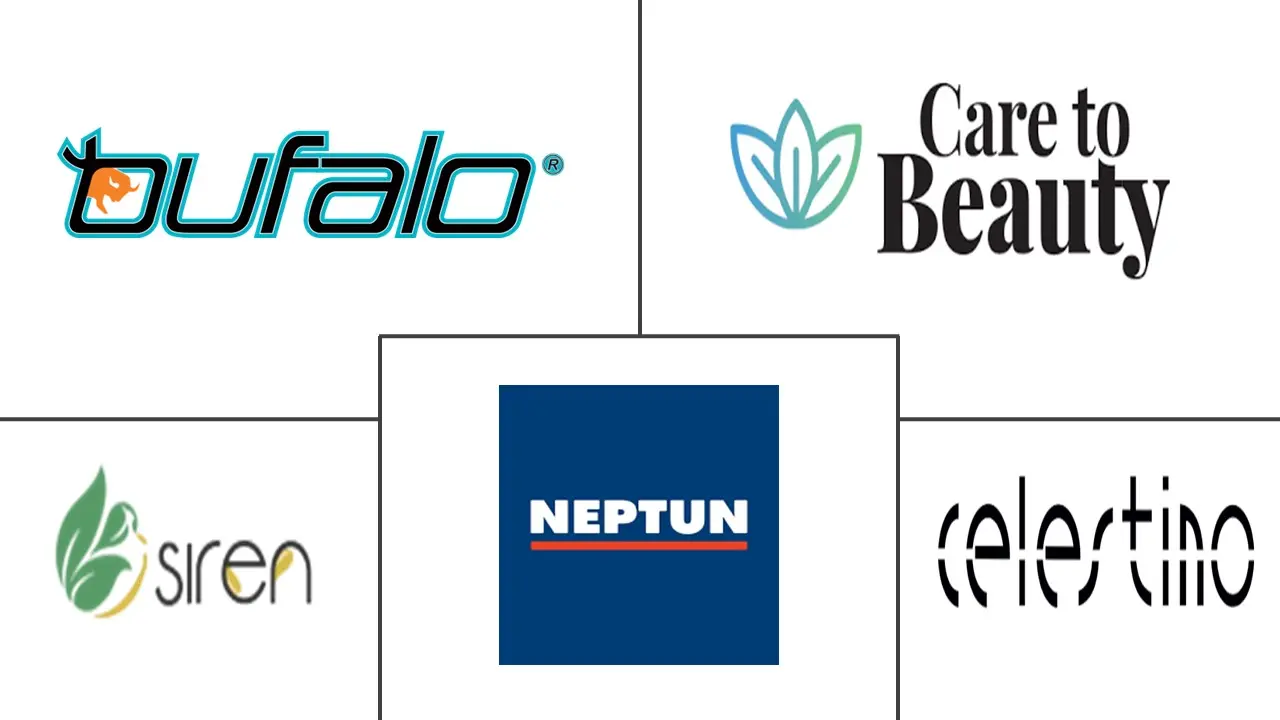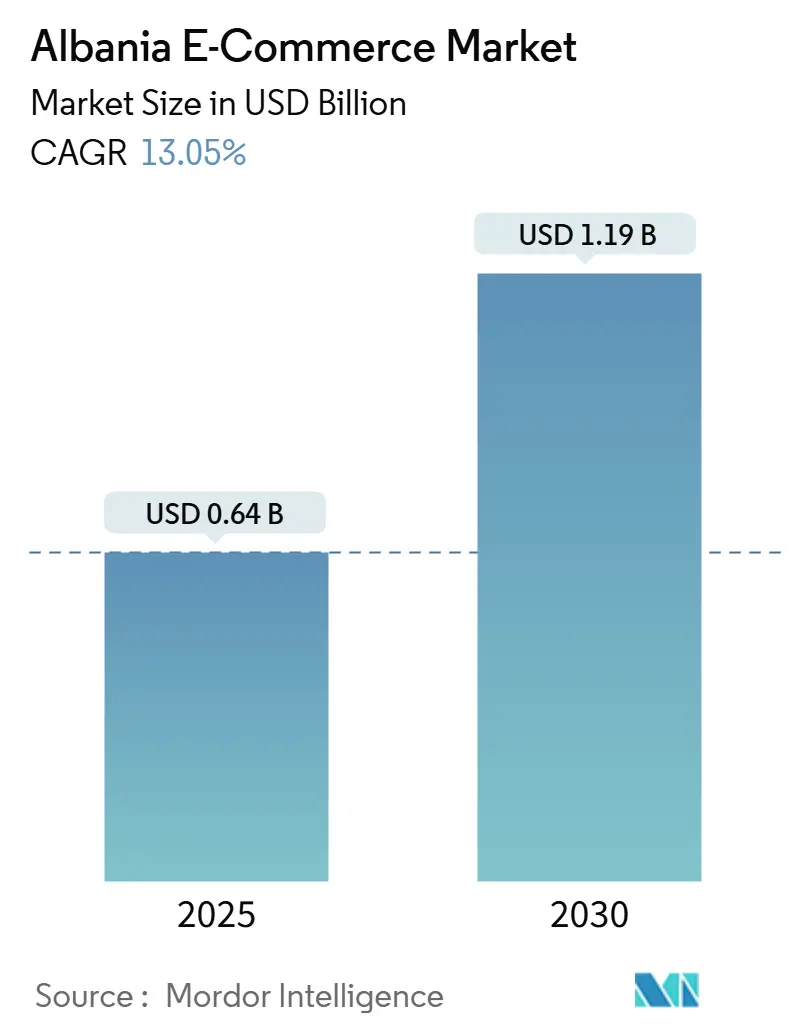
Albania E-Commerce Market Analysis by Mordor Intelligence
The Albania e-commerce market size is valued at USD 0.64 billion in 2025 and is projected to reach USD 1.19 billion by 2030, expanding at a 13.05% CAGR. Momentum is powered by 85.6% internet penetration, mobile connections equal to 143% of the population, and sharply lower cross-border Euro payment costs after the country’s November 2024 entry into SEPA.[1]Bank of Albania, “SEPA Membership Press Release,” bankofalbania.org Solid macro-fundamentals 3.4% GDP growth in 2025, record EUR 1.5 billion (USD 1.6 billion) FDI, an 8.7% lek appreciation versus the Euro, and EUR 3.2 billion (USD 3.4 billion) tourism receipts bolster household purchasing power and reinforce consumer confidence.[2]World Bank Group, “Western Balkans Regular Economic Report,” worldbank.org Consumption is migrating online at scale as fixed broadband speeds climb to 76.06 Mbps and mobile to 57.95 Mbps, reducing checkout abandonment and enabling richer digital experiences. The Albania e-commerce market benefits further from EU-funded fiber roll-outs, the 2023 e-money framework that triggered Albania’s first Open-Banking transaction in March 2025, and the arrival of 48-hour delivery standards that narrow the logistics gap with Western Europe.
Key Report Takeaways
- By business model, the B2C segment held 82.07% of the Albania e-commerce market share in 2024, while B2B is forecast to grow at 16.24% CAGR through 2030.
- By device type, smartphones captured 71.46% of transactions in 2024 and are projected to expand at a 15.26% CAGR to 2030.
- By payment method, cash-on-delivery retained 78.36% share of the Albania e-commerce market size in 2024; digital wallets record the fastest CAGR at 17.36% to 2030.
- By B2C product category, fashion and apparel led with 32.06% share of the Albania e-commerce market size in 2024, while food and beverages accelerate at 18.07% CAGR through 2030.
Albania E-Commerce Market Trends and Insights
Drivers Impact Analysis
| Driver | (~) % Impact on CAGR Forecast | Geographic Relevance | Impact Timeline |
|---|---|---|---|
| Government-led Fiber Roll-out under National Broadband Plan | +2.8% | National, with priority in Tirana and major urban centers | Medium term (2-4 years) |
| Remittance-fuelled Growth in Household Disposable Income | +3.2% | National, strongest in rural areas with diaspora connections | Long term (≥ 4 years) |
| Adoption of Mobile Wallets Post 2023 E-money Regulation | +2.1% | National, with early adoption in urban centers | Short term (≤ 2 years) |
| Entry of Global Integrator-led 48-hour Delivery Services | +1.9% | Tirana metropolitan area, expanding to coastal cities | Medium term (2-4 years) |
| Domestic Fashion Exporters Leveraging E-commerce Channels | +1.5% | National, concentrated in textile production regions | Medium term (2-4 years) |
| Source: Mordor Intelligence | |||
Government-led Fiber Roll-out under the National Broadband Plan
Nationwide fiber is closing the infrastructure gap that once constrained the Albania e-commerce market. Backed by EU integration funds, the plan prioritizes Tirana and tier-2 cities where online demand clusters. Huawei’s Universal Transport Solution lifted backbone capacity from 20 Mbit/s to 10 Gbit/s, and fixed median speeds reached 76.06 Mbps in 2025, supporting multimedia-rich storefronts and lowering cart-abandonment.[3]Huawei Technologies, “Universal Transport Solution Deployed in Albania,” huawei.com Faster, more reliable access clears the runway for augmented-reality try-ons, real-time inventory, and video commerce, making the domestic market more attractive to global platforms.
Remittance-fuelled Growth in Household Disposable Income
Recurring inflows from the Albanian diaspora inject liquidity directly into rural households, sustaining demand across the Albania e-commerce market as physical retail options remain limited outside urban zones. The current-account balance turned a 0.2% surplus in 2023, and recipients increasingly channel funds into smartphones and broadband subscriptions that expand the digital consumer base. With SEPA reducing Euro-transfer costs fivefold, cross-border spending on international e-commerce sites should intensify over the forecast horizon.
Adoption of Mobile Wallets Post 2023 E-money Regulation
Bank of Albania Regulation 59/2021 clarified licensing for payment and e-money institutions, lowering barriers for fintech entrants and boosting consumer trust. EasyPay and Intesa Sanpaolo executed the first Open-Banking payment in March 2025, showcasing instant, account-to-account checkout suitable for high-frequency purchases. Electronic payments grew 25.5% in 2023, setting a flywheel that shifts transactions away from cash-dominated methods and supports the 17.36% CAGR projected for wallet payments.
Entry of Global Integrator-led 48-hour Delivery Services
International 3PLs now guarantee two-day delivery within the Tirana corridor, shrinking fulfillment times that once dampened demand for imported goods. Harmonised customs procedures and average tariffs of 6.6% lower the landed cost for cross-border orders. New service levels strengthen consumer trust, enable impulse buys, and give domestic sellers parity with European peers.
Restraints Impact Analysis
| Restraint | (~) % Impact on CAGR Forecast | Geographic Relevance | Impact Timeline |
|---|---|---|---|
| 78% Cash-on-Delivery Driving High Return Rates | -2.4% | National, particularly pronounced in rural areas | Short term (≤ 2 years) |
| Fragmented Address System Outside Tirana | -1.8% | Rural and semi-urban areas outside major cities | Medium term (2-4 years) |
| Fulfilment Costs at 18% of GMV due to Low Automation | -1.6% | National, most severe in last-mile delivery | Medium term (2-4 years) |
| FX Volatility of ALL vs EUR Elevating Gateway Fees | -1.3% | National, affecting cross-border transactions | Short term (≤ 2 years) |
| Source: Mordor Intelligence | |||
78% Cash-on-Delivery Driving High Return Rates
Cash-on-delivery still accounts for 78.36% of orders, generating return rates up to 25% twice prepaid levels because shoppers commit no funds until the parcel arrives. The Albania e-commerce market must finance larger working capital buffers and absorb extra reverse-logistics costs, eroding margins. Though electronic payments rose 25.5% in 2023, switching deep-rooted consumer habits will require sustained trust-building, BNPL roll-outs, and seller guarantees backed by regulators.
Fragmented Address System Outside Tirana
Patchy street-numbering and postal codes add complexity to last-mile operations beyond the capital, where roughly 60% of Albanians live. Manual address verification inflates fulfillment costs to 18% of GMV versus 8-12% in the EU. While administrative reforms tied to EU accession will eventually standardise addressing, timelines stretch beyond 2028. Until then, retailers focus on urban clusters, limiting the Albania e-commerce market’s geographic reach and underserving rural demand.
Segment Analysis
By Business Model: Consumer Dominance, Corporate Catch-up
B2C accounted for 82.07% of the Albania e-commerce market in 2024, buoyed by a middle class whose wages rose 12.7% and unemployment fell to 10.7%. Fashion secured a commanding 32.06% share as 1.20 million Instagram users track style trends, while food delivery and electronics broaden the basket. Intensifying social-commerce integrations and influencer-marketing campaigns should keep B2C as the principal growth engine through 2030.
B2B transactions, however, clock the briskest 16.24% CAGR. Some 7,475 manufacturing companies and 1,395 wholesalers are digitising procurement to shave transaction costs and gain inventory visibility. Platforms that overlay credit scoring and instant payment options may accelerate enterprise adoption, positioning the Albania e-commerce market size for B2B to approach parity with retail in the long term.
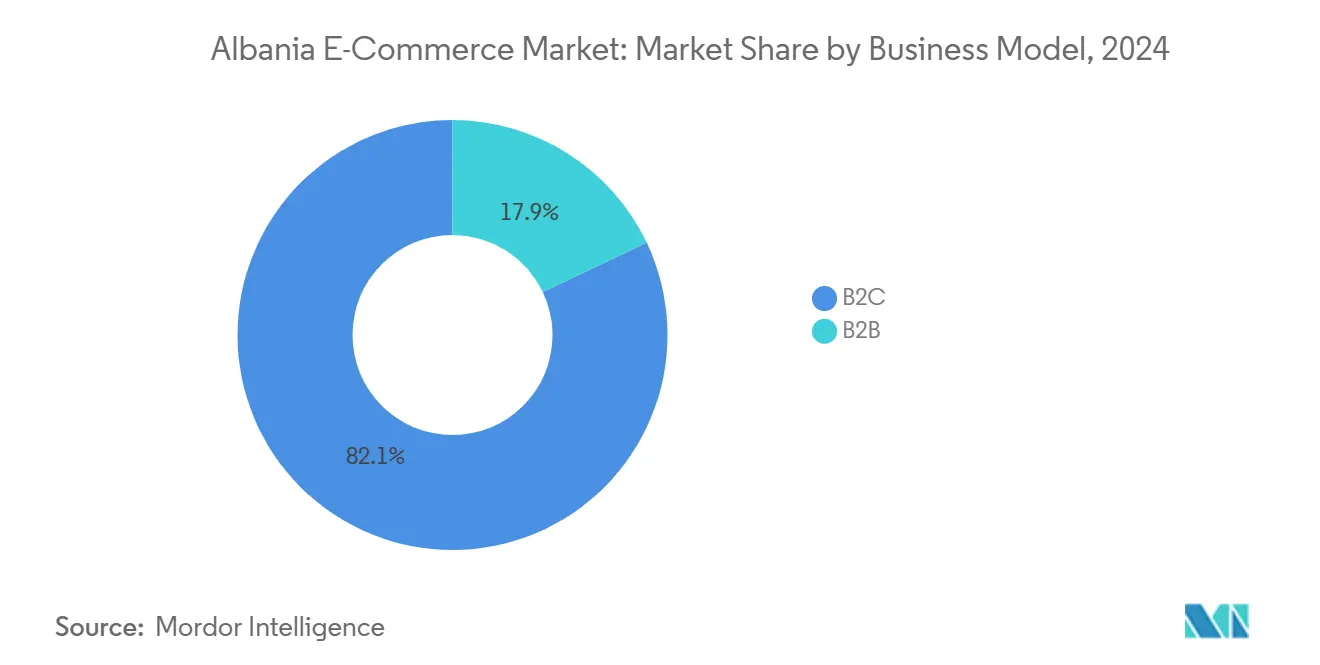
By Device Type: The Smartphone Paradigm
Mobiles generated 71.46% of orders in 2024 and will compound at 15.26% CAGR as broadband-grade 4G/5G reaches 88.6% of connections. Social platforms now embed one-click checkout, deep-linking ads to merchant catalogues optimised for vertical screens. Desktops retain a niche for high-ticket B2B purchases requiring specification downloads, while tablets and smart TVs are emerging frontiers for the Albania e-commerce industry, particularly for video-rich categories such as home décor.
By Payment Method: Digital Wallets Gain Ground
Cash-on-delivery still dominates, but wallet payments exhibit the fastest trajectory. The Albania e-commerce market size for digital-wallet transactions is forecast to rise 17.36% annually on the back of regulation-enabled fintech entry and consumer incentives such as fee-free transfers. BNPL pilots could further chip away at COD if merchants and banks underwrite risk collaboratively.
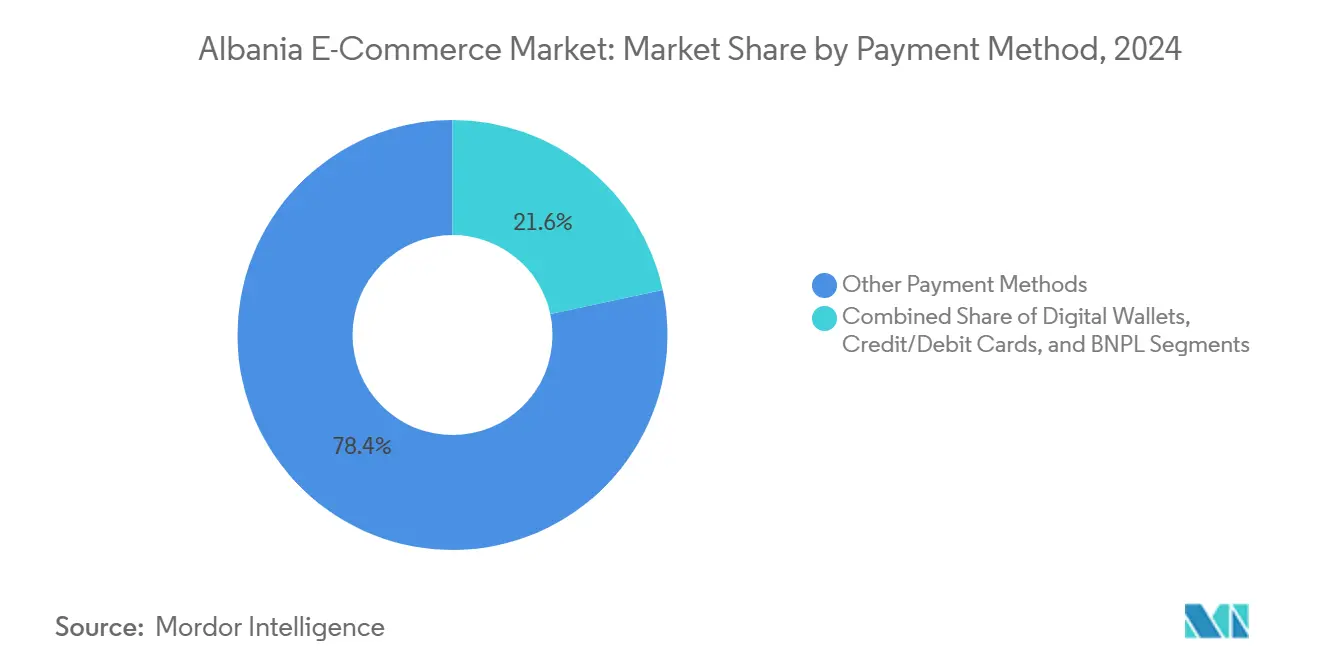
Note: Segment shares of all individual segments available upon report purchase
By B2C Product Category: Fashion Leads, Food Accelerates
Fashion’s 32.06% slice of the Albania e-commerce market share reflects both domestic production capacity and youth-led demand for international labels. Electronics, beauty, and home goods rank next as cross-border merchants plug assortment gaps. Yet food & beverage, currently smaller, is poised to grow 18.07% CAGR, propelled by rapid-delivery apps servicing a surging tourism segment that saw EUR 3.2 billion (USD 3.4 billion) inflows in 2023. Fresh-produce boxes and speciality imports illustrate the sector’s upside as cold-chain logistics improve.
Geography Analysis
Urban Albania anchors online retail. Tirana houses the densest digital-wallet user base and the most advanced fulfilment hubs, attracting investments from BALFIN’s SPAR and Big Market, whose omnichannel pilots lifted Q1 2024 sales by 6%. Durres and Vlore follow, leveraging port logistics to streamline cross-border shipping.
Secondary cities such as Shkoder gain from spill-over effects as fibre rolls out and 48-hour delivery promises expand. Government subsidies are earmarked for last-mile lockers and micro-fulfilment centres that shorten rural lead times, adding headroom for the Albania e-commerce market to grow outside metropolitan strongholds.
Rural districts remain payment-constrained yet represent latent demand. Remittances and smartphone adoption are narrowing the gap, while SEPA entry slashes fees on inbound euros, giving villagers better price parity on international sites. Once address standardisation materialises, rural GMV could unlock a step-change in the Albania e-commerce market trajectory.
Competitive Landscape
The Albania e-commerce market features moderate fragmentation. Amazon and AliExpress dominate cross-border volume by virtue of assortment depth and seller tools. Local champion Gjirafa50 trades more than 300,000 SKUs and posts record conversions during Black Friday due to Albanian-language navigation and COD flexibility.
Traditional conglomerates pivot online. BALFIN Group converted several Neptun electronics stores into dark warehouses to enable same-day delivery, while SPAR Albania integrated its loyalty card into a proprietary app that supports wallet top-ups. These omnichannel plays defend brick-and-mortar traffic and recycle logistics assets already spanning the country.
Competition is shifting toward payments and fulfilment. EasyPay’s Open-Banking rails let smaller merchants accept account-to-account checkout at lower fees, eroding card-scheme dependence. International 3PLs negotiating bonded warehouses near Durres port intensify price pressure on domestic couriers. M&A activity is expected as platforms seek scale economies and data breadth to improve recommendation algorithms and reduce return rates.
Albania E-Commerce Industry Leaders
-
Bufalo.al (Bufalo Sh.p.k.)
-
Celestino S.p.A.
-
Neptun Sh.a.
-
Care To Beauty, S.A.
-
Sirena.al (SIRENA-KORCA Sh.p.k.)
- *Disclaimer: Major Players sorted in no particular order
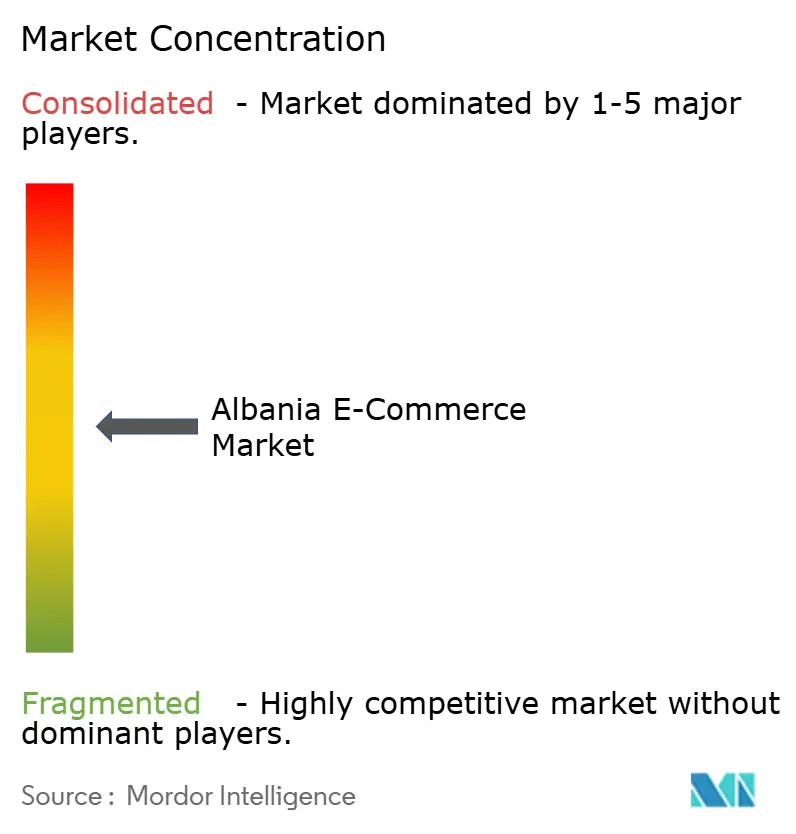
Recent Industry Developments
- March 2025: EasyPay and Intesa Sanpaolo Bank Albania executed the first Open-Banking payment, unlocking instantaneous account-to-account checkout.
- November 2024: Albania entered SEPA, cutting Euro-payment fees fivefold and compressing settlement cycles to one business day.
- October 2024: World Bank raised Albania’s 2025 growth forecast to 3.4% as private consumption, tourism and construction accelerate. Strategy: higher household income underpins discretionary online spending.
- September 2024: Big Market, SPAR and Conad reported 6% retail-sales growth in Q1 2024, crediting click-and-collect roll-outs. Strategy: proves omnichannel synergy and validates further investment in dark-store networks.
Albania E-Commerce Market Report Scope
E-commerce is a cross-industry sales channel that sells or promotes brand awareness online, is considered a sales channel, and is part of a company's digital strategy. Business-to-business (B2B) e-commerce transactions occur between companies sold in bulk by the supplier. Business to Consumer (B2C) means that a company sells its products to its customers directly from its website or online marketplace. A set of software technologies built into a company's website. This allows companies to request products and services from their websites and complete the sales cycle. The studied market will investigate the impact of e-commerce on Albania, provide the various trends, drivers and challenges faced in the country, and provides information on major domestic companies that innovate new solutions in the ecommerce market.
| B2C |
| B2B |
| Smartphone / Mobile |
| Desktop and Laptop |
| Other Device Types |
| Credit / Debit Cards |
| Cash on Delivery |
| Digital Wallets |
| BNPL |
| Other Payment Method |
| Beauty and Personal Care |
| Consumer Electronics |
| Fashion and Apparel |
| Food and Beverages |
| Furniture and Home |
| Toys, DIY and Media |
| Other Product Categories |
| By Business Model | B2C |
| B2B | |
| By Device Type | Smartphone / Mobile |
| Desktop and Laptop | |
| Other Device Types | |
| By Payment Method | Credit / Debit Cards |
| Cash on Delivery | |
| Digital Wallets | |
| BNPL | |
| Other Payment Method | |
| By B2C Product Category | Beauty and Personal Care |
| Consumer Electronics | |
| Fashion and Apparel | |
| Food and Beverages | |
| Furniture and Home | |
| Toys, DIY and Media | |
| Other Product Categories |
Key Questions Answered in the Report
What is the current size of the Albania e-commerce market?
The market is worth USD 0.64 billion in 2025 and is forecast to reach USD 1.19 billion by 2030 at a 13.05% CAGR.
Which segment holds the largest share of the Albania e-commerce market?
The B2C segment leads with 82.07% share in 2024, underpinned by fashion and apparel demand.
Are digital wallets replacing cash-on-delivery in Albania?
Not yet; COD still accounts for 78.36% of orders, but wallet transactions are growing at 17.36% CAGR due to supportive regulation and Open-Banking adoption.
How fast is mobile commerce growing in the Albania e-commerce market?
Mobile transactions already represent 71.46% of total orders and are expanding at 15.26% CAGR helped by 57.95 Mbps median mobile speeds.
What impact will SEPA membership have on Albanian online retail?
SEPA slashes Euro transfer fees and settlement times, lowering barriers for EU merchants and boosting cross-border sales opportunities.
How fragmented is the competitive landscape?
The five largest players command 28% share, indicating moderate fragmentation and ongoing room for local and niche platforms to scale.
Page last updated on:
